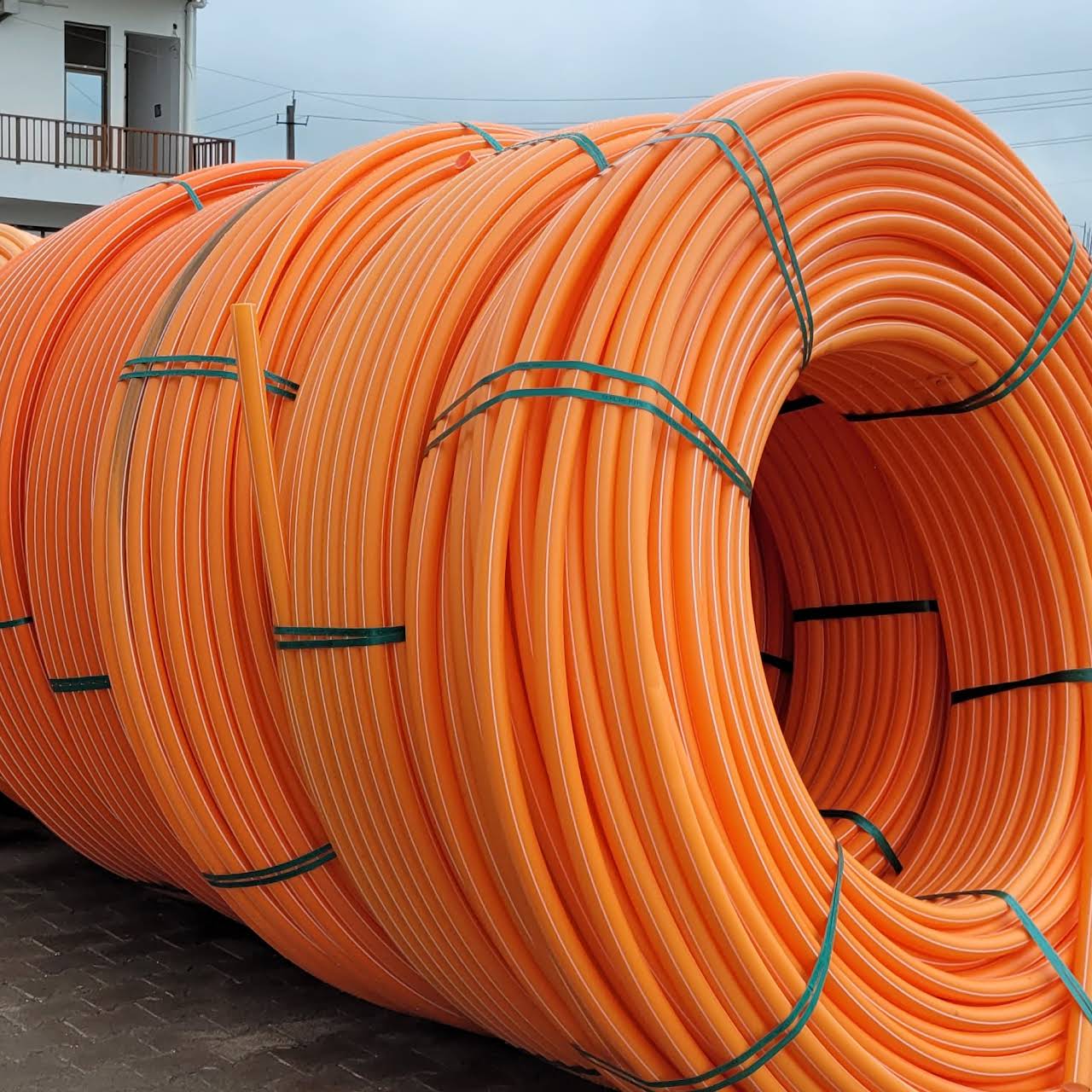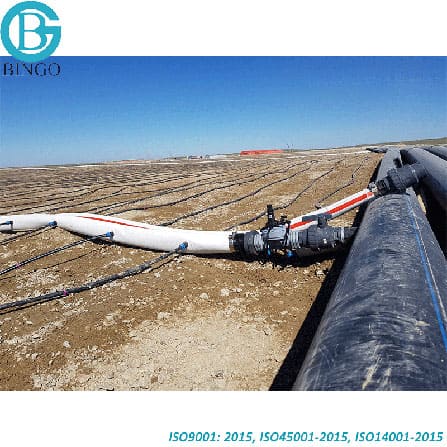American Plastics HDPE Pipe for Oilfield: Efficiency in Harsh Environments
Wiki Article
Explore the Manufacturing Refine Behind High-Quality HDPE Pipeline and Its Applications
The manufacturing process of high-grade HDPE pipes is detailed and systematic. It starts with the selection of basic materials that improve performance. Following this, ethylene undergoes polymerization to form material, which is after that formed via extrusion. Quality control is paramount, ensuring that the end product meets rigorous requirements. The trip of HDPE pipes doesn't end with production. Their applications throughout different markets reveal a broader relevance worth analyzing.Recognizing HDPE: Qualities and Advantages

High-density polyethylene (HDPE) is a versatile polycarbonate recognized for its durability and resistance to various ecological factors. This material displays superb tensile toughness, making it suitable for requiring applications. Its low-density structure contributes to a light-weight product, facilitating ease of dealing with and installation. HDPE also showcases amazing resistance to chemicals, which lessens destruction when subjected to severe substances.
The product's low wetness absorption further improves its long life, making it perfect for use in pipes and tank. Additionally, HDPE is resistant to ultraviolet (UV) radiation, making certain that items keep their stability even when exposed to sunlight. Additionally, its flexibility permits for the development of elaborate shapes without jeopardizing toughness. The environment-friendly nature of HDPE, typically stemmed from recycled materials, adds to its charm, promoting lasting methods in production. Overall, these buildings and advantages make HDPE a favored choice for various industrial and consumer applications.
Raw Material Selection for HDPE Production
The selection of basic materials for HDPE manufacturing is necessary to confirm the last product fulfills the wanted requirements and top quality criteria. High-density polyethylene (HDPE) is largely created from polymerized ethylene, acquired from nonrenewable fuel sources such as gas or petroleum. The top quality of these feedstocks considerably influences the mechanical and thermal properties of the last HDPE.Additives likewise play a substantial role in boosting HDPE's performance, including anti-oxidants, UV stabilizers, and colorants, which improve toughness and resistance to ecological aspects. The selection process have to consider not just the chemical composition of the raw products however additionally their processing features to guarantee reliable production.
Furthermore, the sourcing of resources ought to prioritize sustainability and conformity with ecological regulations, as responsible methods are imperative in today's market. Ultimately, careful raw material selection lays the foundation for generating high-quality HDPE pipes suitable for diverse applications.
The Extrusion Refine: Shaping HDPE Pipeline
The extrusion procedure plays a crucial function in forming HDPE pipes, starting with careful product preparation techniques that ensure ideal circulation and uniformity. Equally vital is the style of the die, which straight influences the last measurements and surface top quality of the pipe. With each other, these factors add significantly to the efficiency and top quality of HDPE pipeline production.Material Prep Work Techniques
Effective production of HDPE pipelines begins with thorough product preparation strategies, particularly the extrusion procedure. Throughout this phase, high-density polyethylene material is first dried out to remove moisture, ensuring ideal flow features. The material is then fed into the extruder, where it undertakes home heating and melting, transforming into a viscous state. This home heating procedure is meticulously regulated to preserve the product's integrity and performance. The molten HDPE is required through a die, forming it into a constant pipeline type. Proper temperature level administration during extrusion is important, as it straight influences the material's buildings and the final product high quality. Once formed, the HDPE pipe is cooled and cut to specified sizes, prepared for succeeding processing and applications.Die Layout Value
Precision in die design plays a vital role in the extrusion procedure of HDPE pipelines. The die works as the last shaping device, straight influencing the pipe's dimensions, wall density, and surface area finish. A well-designed die assurances uniform product circulation, minimizing defects such as abnormalities and vulnerable points. The geometry of the die have to be maximized to suit the particular properties of HDPE, including its thickness and thermal habits throughout extrusion. In addition, the cooling price of the product as it travels through the die can substantially affect the pipeline's architectural honesty. Subsequently, buying sophisticated die modern technology is essential for suppliers aiming to generate top notch HDPE pipes that fulfill industry standards and consumer expectations.Quality Assurance Actions in HDPE Production
Although various factors influence the quality of HDPE pipe production, effective high quality control procedures are critical to ensure consistency and dependability in the end product. Secret quality assurance practices include extensive product assessment, confirming that the raw polyethylene meets well-known criteria for purity and thickness. Throughout the extrusion procedure, parameters such as temperature, pressure, and cooling time are carefully monitored to keep dimensional precision and architectural honestyFurthermore, post-production screening is essential; suppliers frequently conduct hydrostatic tests to assess the pipeline's stamina and resistance to stress. Aesthetic inspections for surface area defects even more enhance quality guarantee. Certification from pertinent criteria organizations, like ASTM or ISO, provides an added layer of integrity. By applying these comprehensive high quality control steps, producers can minimize issues, enhance performance, and ensure that the HDPE pipelines fulfill the certain requirements of various applications, eventually bring about customer complete satisfaction and count on the item.
Applications of HDPE Pipe Across Industries
HDPE pipes are utilized throughout numerous industries because of their resilience and flexibility. In water circulation systems, they guarantee reliable get more info distribution, while in wastewater monitoring, they give dependable solutions for waste transportation. In addition, agricultural irrigation networks take advantage of HDPE's resistance to deterioration and flexibility, making it an optimal selection for modern farming practices.
Water Circulation Solutions
A considerable variety of sectors depend on high-density polyethylene (HDPE) pipelines for reliable water circulation systems. Recognized for their durability and resistance to deterioration, HDPE pipelines are commonly used in community supply of water networks, agricultural watering, and industrial applications. Their lightweight nature promotes very easy handling and installation, decreasing labor costs and time. In addition, HDPE pipelines can fit different pressure levels, making them ideal for both reduced and high-pressure systems. American Plastics HDPE Pipe Manufacturing. The adaptability of the material permits seamless assimilation right into existing framework, minimizing the demand for comprehensive excavation. HDPE's resistance to chemical seeping warranties that the water provided remains safe and clean, making it an ideal selection for preserving the quality of drinkable water across different industries.Wastewater Administration Solutions
Effective water circulation systems also lead the way for cutting-edge wastewater monitoring remedies, where high-density polyethylene (HDPE) pipelines play a substantial duty. Popular for their resilience and resistance to deterioration, HDPE pipelines are ideal for transporting wastewater in various settings. Their adaptability permits simple installation in intricate atmospheres, lessening the demand for considerable excavation. Additionally, HDPE's smooth indoor surface decreases friction, enhancing circulation prices and performance. These pipelines are also resistant to chemical leaching, guaranteeing that contaminants do not jeopardize the surrounding environment. Industries, towns, and therapy centers significantly count on HDPE pipes for their dependability and durability, making them a favored selection for modern-day wastewater management systems. This versatility highlights the vital relevance of HDPE pipelines throughout many applications.Agricultural Irrigation Networks
Agricultural irrigation networks profit considerably from the usage of high-density polyethylene (HDPE) pipelines, which supply effective and trustworthy water delivery to plants. HDPE pipelines are lightweight, making them simple to deliver and mount, while their adaptability enables different arrangements in diverse surfaces. These pipelines demonstrate excellent resistance to deterioration, chemicals, and UV radiation, making sure durability in extreme agricultural atmospheres. Additionally, their smooth interior surface minimizes rubbing loss, enhancing water flow and lowering power costs related to pumping. The longevity of HDPE pipes, often surpassing half a century, adds to lower maintenance and substitute expenditures. Farmers progressively rely on HDPE pipelines to boost watering performance and promote sustainable farming methods, eventually leading to enhanced crop returns and resource preservation.
Future Fads in HDPE Pipe Modern Technology
As the need for lasting and efficient facilities expands, innovations in HDPE pipeline innovation are positioned to transform numerous industries. Arising patterns include the assimilation of wise modern technologies, such as sensors and IoT capacities, which facilitate real-time monitoring of pipeline conditions, decreasing maintenance costs and preventing leaks. In addition, the growth of sophisticated production techniques, such as 3D printing, is enabling the manufacturing of complex, personalized pipeline layouts that accommodate specific project requirements.The emphasis on recycling and circular economic situation methods is driving the development of HDPE pipelines made from recycled products, enhancing sustainability. Improved jointing methods, such as electro-fusion and mechanical fittings, are also enhancing setup effectiveness and reliability. The expanding focus on ecological policies is pushing manufacturers to take on greener manufacturing processes, making certain that HDPE pipes not just satisfy market standards however likewise cultivate an even more lasting future for infrastructure development.
Frequently Asked Concerns
Just How Does HDPE Compare to Various Other Plastic Materials?
HDPE exceeds numerous other plastic materials pertaining to resilience, chemical resistance, and flexibility. Its low density and high tensile strength make it perfect for various applications, usually exceeding options in both performance and long life.What Are the Environmental Influences of HDPE Manufacturing?
The environmental impacts of HDPE production consist of greenhouse gas emissions, energy consumption, and prospective contamination from making processes. In addition, improper disposal can bring about dirt and water contamination, increasing concerns about long-term environmental effects.Can HDPE Pipeline Be Reused?
Yes, HDPE pipelines can be reused. Several facilities accept made use of HDPE for handling, transforming it right into brand-new products. This reusing adds to sustainability efforts, lowering plastic waste while preserving resources and energy in the manufacturing cycle.What Is the Lifespan of HDPE Piping?

How Do Temperature Variants Affect HDPE Pipe Performance?
Temperature variations substantially impact HDPE pipe performance, impacting adaptability and strength. High temperature levels can cause softening, while low temperatures might trigger brittleness, eventually affecting the pipeline's longevity and viability for numerous applications in diverse atmospheres.Report this wiki page